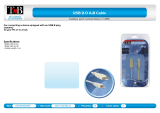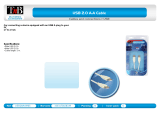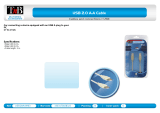Page is loading ...

bThisproductisnotasafetycomponentasdenedinthe
Machinery Directive.
b The Visionary-B is a driver assistance system designed
to enhance collision awareness. It assists drivers. Driver
assistance systems are not a substitute for driving with due
care and attention!
b Themounting,electricalinstallation,andcongurationofthe
devicemustbecarriedoutbyprofessionallyqualiedand
trained personnel only.
b Prior to mounting, it is imperative that you follow the
machine manufacturer’s operating instructions and agree
on possible mounting positions with the manufacturer in
advance, where appropriate.
b When mounting and electrical installation work is being car-
ried out, always comply with standard operating procedures,
health regulations, and environmental regulations in force.
b The assistance system must not be used in areas with
ammable/explosiveatmospheres!
b Be sure to observe electrical connection values during
installation.
b Use only the cables provided to install the device.
b Replace faulty or damaged cables and male connectors
immediately.
b Replace damaged or faulty components immediately and in
consultation with SICK AG.
b When mounting the device, it is imperative that you use
suitable mounting equipment and that you consider its
specictighteningtorques.Themountingequipmentmust
be self-locking or secured appropriately.
b Ensure a constant voltage supply to the device within the
prescribed parameters.
b Operate the assistance system only within the prescribed
operating parameters.
b Regularly check that the assistance system is functioning
properly, e.g., at the end of the working day.
b Do not cover the evaluation unit and ensure proper heat
dissipation at the mounting position.
b Structuralmodicationstothesystemarenotpermitted!
Visionar y-B
3D driver assistance system to
enhance collision awareness
8022058/9PMS(2018-07-13
All rights reserved. Subject to change without notice.
QUICK START
Visionary-B CV
Completing the mechanical and electrical
set-up
Preparing for mounting
Safety
Product features
Scope of delivery
Checking the conguration
Conguring the HMI
Overview
Conguring the HMI
Note: With kit C, the mounting and electrical installation
must be carried out for both evaluation units and
sensor heads.
1. Mountthedisplayusingthebracketinsidethedriver’s
cab(1)sothatthedrivercaneasilyseeitatalltimes
(e.g.,onthedashboard).
2. Mount the evaluation unit at the designated installation
position. To do so, use the mounting screws provided or
othersuitablettings.
Note: Theevaluationunitmustbeswitchedowhenitis
connected to the peripheral systems, otherwise the
components may become damaged.
3. Connectthedisplayandtheevaluationunit.
Visionary-B
Visionary-B
Visionary-B
4. Mount the bracket provided for the sensor head.
5. Mount the sensor head on the prepared bracket on the
vehicle.
6. Set the sensor head bracket to the designated tilt angle.
7. Connecttheconnectingcabletothesensorhead(s)and
the evaluation unit.
8. Switchothevehicle’signition.
Note: Pleasebeawarethatthecablesandthefuseboxof
your machine may still be energized.
9. Pressthemainbatteryswitchandinterruptthepower
supply to the connections for the vehicle’s electrical
system.
Note: Protect the evaluation unit against electrical
overstress. To do this, you can use the supplied fuses.
Please note that failure to observe this measure will
invalidate any warranty claims.
10. Connecttheevaluationunit(s)tothepreparedconnec-
tions of the vehicle’s electrical system.
11.ConnecttheUSBkeyboardandmousetotheevaluation
unit in order to carry out initial commissioning.
b With kit C, this process must be carried out on both
evaluation units.
1. Switchonthevehicle’signitionandwaitforawarning
sign to appear.
2. Press the ESC button.
Note: TheGermankeyboard(QWERTZ)willbeactivatedas
standard.ThiscanbechangedintheConguration
menu.
3. Enterthepassword.
TheCongurationscreenisdisplayed.
6. Acknowledge the note on the left-hand side by clicking
the Please click here button.
7. Selectthelanguageusingthedrop-downmenuinthetop
left-hand corner.
8. Using the drop-down menu item Quick settings, choose
fromthepre-congurations(harsh: recommended
for outdoor use; moderate: not recommended for use
under real-life conditions, surroundings with optimum
environmentalconditions).
Note: With kit B, this setting enables access to the second
alarm zone.
9. Enterthesensorhead’sheightandinstallationangle.
b Other parameters can be set using the drop-down menu
item Advanced settings.
10. Enterthevehicle’sdimensions.
11. Clicktheorangevehiclesymbol(standard:boxwith
arrow)toaccessachoiceofvehiclemodelstobeableto
visualize the settings better.
12. Selectoneofthevehicle’svisualizations(aerialview).
13. Clickonthesensorhead(blue)inthegraphicinorderto
access the sensor head’s settings.
Move one of the two points in order to move or rotate the
position of the sensor head in relation to the vehicle.
14. Enterthevaluesrelatingtothepositionandalignment
of the sensor. The coordinates can be found in the top
left-hand corner on the vehicle.
Flipped view Provides mirror image of sensor
head information on the HMI
display
b Driver assistance to enhance collision awareness.
bPerfectlydesignedforo-roadheavytrucksworking
outdoors.
b2-in-1:active3Dsensorand2Dcamera.
bSensorheadtemperaturerange:−40°C…+75°C.
bVeryruggedhousingforoutdooruse:IP69Kforthesensor
head.
b Relevant objects are reliably recognized within a sensing
rangeofupto7m,largelyirrespectiveofenvironmental
inuences–evenstrongsunshineorrain.
bThe3Dsensorprovidesalive2Dimagewithavisualand
audible warning to enhance collision awareness.
b For optimal detection performance, the sensor head should
beinstalledataheightof1mto2.4m.
bCongurationanddataoutputdirectlyviathemonitor(s)
provided.
b Detailedinformationonthescopeofdeliveryofallkits(A,Band
C)andvariantscanbefoundintheoperatinginstructionsof
Visionary-BCV(8022960).
Visionary-Bisa3Ddriverassistancesystemdesignedto
avoid collisions in an outdoor environment. It is based on the
stereoscopicprincipleandprovidesrealtime3Ddataatupto
10framespersecond.
TheassistancesystemisconguredusingtheHMIandaUSB
keyboard/mouse(seenote)andpresentsthesettingonthe
monitor in real time.
Oncecongured,itrunsinstand-aloneoperationand
continuously provides results when the ignition is switched
on. The live images appear on the display and the driver is
notiedofanybreachesofthe3Ddetectionareawithvisual
and audible warnings.
In order to be able to use the assistance system, you must
followtheoperatingstepsbelow:
1. Completingthemechanicalandelectricalset-up
2. ConguringtheHMI
3. Settingthedetectionareas
Note: SystemcongurationrequiresaUSBkeyboard/
mouse combination to be used. The connection is
established via a USB port. Only trained personnel
maycarryoutthecongurationwork.Innormal
operation, connecting a keyboard and mouse is
forbidden.
SICK products meet industrial standards. The focus is on
availability of products and services. SICK always assumes
thattheintegrityandcondentialityofthedataandrights
aectedbytheuseoftheaforementionedproductswillbe
ensured by the customer.
Exclusion from liability
EN
1. Switchthesystemonattheignitionifthishasnotbeen
done already.
2. Wait until the camera image appears on the display.
3. Checkthealignmentofthecameraimage(normal/
ipped).
4. Press the “i” button. The values displayed for Height
andAnglefortheconguredanddetectedlinesshould
be similar.
Note: ThevaluesforEstimatedandInitialHeight/Angle
mustbeatleastslightlydierent.Ifthesetwo
values are identical, the sensor head has not been
correctly installed and no reliable alarm will be
triggered if the alarm zone is breached!
5. Check whether the vehicle illustration, sensor head
position,anddetectionarea(shownontheright-hand
sideofthedisplay)matchtheenteredsettings.With
kit B, switch between the two sensor heads with the “g”
button.
6. Check whether the alarm is triggered when the detec-
tion area is breached.
Ifoneofthethoroughchecksisnegative(alsoseenote),
youmustrepeatthecongurationprocess.
Youcanndadditionalinformationaboutthebuttonassign-
ments in the operating instructions.
Parameter Description
Angle Installation angle of the sensor
head
in relation to the horizontal
Height Mounting height of the sensor
head
(inrelationtothecenterof
thelenses)
Location and
positioning
X/Y–Distancetotheleft-hand
side/frontofthevehicle
Slidecontrol–Alignmentofthe
sensor head in degrees
(0°:forwards,90°:left)
Alarm Alarm performance dependent on
the gear selected.
Active:Analarmwillbetriggered
if the detection zone is breached
when this gear is selected.
Sharp slopes Alarm performance dependent on
sharp slopes.
Active:Improvesdetectionifthe
territory is hilly.
15. Clickononeoftheredareasinordertosetthevalues
forthealarmzones(see
B
).Thevaluesaresetrelative
to the position of the sensor. Pay attention to the
general conditions such as height, distance, etc., in
thetechnicaldata(see
D
).Foradditionalconguration
options, see the HMI and operating instructions.
b ForkitB,selectthesensorheadtobeconguredusing
the
and symbols.
16. Clickontheredcrosssymbolinthetopright-hand
cornerinordertoquitthecongurationprocess.
Additional information
For additional information on the assistance system, please
see the operating instructions or visit www.sick.com. Please
contactyourlocalsalesoceintheeventofanysupport
queries.Thepasswordsrequiredforcongurationcanalsobe
obtained from the manufacturer service.
Part no. Description
2098100 Cableforconnectingthesensorhead/
evaluationunit(3m)
2098101 or Cableforconnectingthesensorhead/
evaluationunit(5m)
2098102 or Cableforconnectingthesensorhead/
evaluationunit(10m)
2098103 or Cableforconnectingthesensorhead/
evaluationunit(15m)
2098104 or Cableforconnectingthesensorhead/
evaluationunit(20m)
2086211 Alarm cable for two discrete outputs,
0/12V(5m)
Note: In order to correctly connect the system, one of
these cables must be used! Two cables are required
respectively for kit B and kit C.
Necessary accessories
Note: KitsBandCeachhavetwosensorheadstomount–
kitBhasanadditionalswitchboxandkitChasan
additional evaluation unit. Ensure that additional
space is made available and that mounting steps are
repeated when necessary.
1. Preparethesensorheadmountingposition(3)byxing
a stable holding device. Pay attention to the values for
the detection zone and the sensor head’s permitted
environmental parameters.
2. Install the connecting cable for the sensor head between
the sensor head mounting position and the driver’s cab
(necessaryaccessories).
Install it along protected areas of the vehicle as much as
possible(e.g.,recesses,grooves,etc.).
Note: Ensure that the cable cannot become squashed,
pulled, or kinked. Use the most heavy-duty cable
channels possible.
Note: Do not cover the evaluation unit and ensure proper
heat dissipation at the mounting position.
Ensurethattheevaluationunitisnotexposedto
direct sunlight.
3. Preparethemountingpositionfortheevaluationunit(2)
by getting the connection ready at the installation
position inside the driver’s cab.
Use the most heavy-duty cable channels possible here as
well or lay the cable under the inner lining.
Note: Ensure that the USB connection of the evaluation unit
is accessible for maintenance purposes.
Australia
Phone +61394570600
1800334802–tollfree
Austria
Phone +43223662288-0
Belgium/Luxembourg
Phone+3224665566
Brazil
Phone +55113215-4900
Canada
Phone +19057711444
Czech Republic
Phone +420257911850
Chile
Phone+56222747430
China
Phone+862028823600
Denmark
Phone +4545826400
Finland
Phone +358-9-2515800
France
Phone +33164623500
Germany
Phone +492115301-301
Hong Kong
Phone+85221536300
Hungary
Phone +3613712680
India
Phone +912261198900
Israel
Phone +97246881000
Italy
Phone +3902274341
Japan
Phone +81353092112
Malaysia
Phone +60380807425
Mexico
Phone +52(472)7489451
Netherlands
Phone +31302044000
New Zealand
Phone +6494150459
0800222278–tollfree
Norway
Phone +4767815000
Poland
Phone +48225394100
Romania
Phone +40356171120
Russia
Phone +74957750530
Singapore
Phone +6567443732
Slovakia
Phone +421482901201
Slovenia
Phone +38659178849
South Africa
Phone +27114723733
South Korea
Phone +8227866321
Spain
Phone +34934803100
Sweden
Phone +46101101000
Switzerland
Phone +41416192939
Taiwan
Phone +88622375-6288
Thailand
Phone +6626450009
Turkey
Phone +902165285000
United Arab Emirates
Phone +97148865878
United Kingdom
Phone +441727831121
USA
Phone +18003257425
Vietnam
Phone +84945452999
Detailed addresses and further
locations at www.sick.com

C
F
D
E
Connection for voltage supply
(evaluation unit)
Technical data
Connection diagram
Connections (evaluation unit)
A
Dimensional drawings in mm [inch]
B
Detection zone
Visionary-B
Working distance 0.5m...7m
Definable detection zone (∆x x ∆y) 6mx7m
Maximum detection angle 120°x75°
Maximum installation angle (in relation to the hori-
zontal)
See table on detection zone
Detectable object shape See the HMI and operating instructions
Response time < 200 ms typical
Switch-on delay < 50 s
Mounting 1m...2.4m
Mounting position Accordingtothedetectionzone(mustbedelimitedbytheground)
Weight of sensor head 1.3kg
Weight of evaluation unit 3.8kg
Dimensions See dimensional drawings
Protection class IP69K(sensorhead),IP67(evaluationunit)
Supply voltage 12VDC–10%
24VDC+40%
1)
Connections (evaluation unit) 1xUSB(mouseandkeyboard)
2xsensorheads
Monitor(foregroundsuppression/sound)
Additional alarm output, two discrete outputs
Machine-machineinterface(reserved)
Evaluation unit supply
Ethernet(reserved)
Power consumption ≤30Wmax.(kitA)
≤35Wmax.(kitB)
≤60Wmax.(kitC)
1Wignition
0.8 mA at 24 V in standby
Output voltage 12Voutputvoltage
100mAoutputcurrent(overcurrentprotectionmax.430mA)
Light sensitivity 200lux...80,000lux
Ambient temperature (operation) –40°C...+75°C(sensorhead),–40°C...+50°C(evaluationunit)
Ambient temperature (storage) –40°C...+75°C(sensorhead),–20°C...+75°C(evaluationunit)
Impact load (short-term) EN60068-2-29:1994-01(50g/6ms)
Vibration load EN60068-2-64:2008-11(5.9g/10Hz–2kHz)
Electromagnetic compatibility (EMC) EN61000-6-2:2006-03(interferenceimmunityforindustrialenvironments)
EN61000-6-3:2007-01+A1:2011-03(radiatedemissionforresidentialareas)
Further standards ISO13766:2006-05(earth-movingmachinery),EN12895:2015-09(industrial
trucks),EN13309:2010-09(constructionmachinery),
ISO14982:2009-02(agriculturalandforestrymachinery),EN55012:2008-06
+A1:2009,ISO11452-2:2004-11,ISO7637-2:2011-03,
ISO16750-2:2012-11,ISO16001:2017,EN62311:2008
FCCPART15:2006-08
1)
Ensure harmonic-free supply voltage
Thedetectionperformancedependson:
bthedistancetoaatboundarysurface,suchasthe
ground, ceiling, wall, etc.
b the mounting bracket in relation to the ground.
b the ambient conditions.
Themaximumdetectionrangeispre-setto7m.Thisvalue
maydierorbephysicallydelimitedduetoenvironmental
inuencesormountingparameters.
Themaximumdenablealarmzonedependsontheobject
classinquestion;ideallyitshouldbesetto6mx7m
(∆xx∆y,3Dprojectionontheground).Greatervalues
can be set but can only be detected with a lower level of
reliability. For additional information, see the HMI and
operating instructions.
Detection zone
Δy
x,y(0,0)
z
90°
Δx
h
max. detection distance
∆y
Angle of installation
262
10.31
122.4 4.82
133.2 5.24
80
3.15
122.44.82
Power
Data
USB (wireless)Power
supply
Power
Sound
Video (VGA)
)
GND
7,5 A
+Battery
+Discrete signal input (reverse gear)
2,0 A
+Ignition
2,0 A
2,0 A
2,0 A
+Discrete signal input (reserved)
+Discrete signal input
(optional recorder deactivation)
Pin Color Description
1 White GND
2 Brown +Battery
3 Gray +Ignition
4 Green +Discretesignalinput(reverse
gear)
5 Yellow +Discretesignalinput(optional
recorderdeactivation)
6 Pink +Discretesignalinput(reserved)
The connections on the vehicle and evaluation unit side must
be connected identically. Protect the evaluation unit against
overstress, e.g., using the fuses supplied.
276,9 10,9
91,3 3,59
190
7,48
258,9 10,19
30
1,18
80
3,15
6,4 0,25
221
8,7
85
3,35
214.1 8.43
182
7.17
122
4.8
138
5.43
188
7.4
6
0.24
149.8 5.9
R14
0.55
R20
0.79
25.4
1
35
1.38
43
1.69
7
0.28
26.21.03
13.5 0.53
6
0.24
17.80.7
190
7.48
56
2.2
14.50.57
57.12.25
55°
40.8 1.61
34.31.35
DVD
SEL
MENU
CH-
POWER
Service and maintenance
The assistance system does not have any internal parts which
require servicing by the user.
b Check screw connections and terminals regularly.
b Clean the optical areas of the sensor head daily
andintheeventofcontamination.Axthelabel
to the monitor to provide information to the
operator.
b Clean the housing using a soft cloth. Either use
a dry cloth, or dampen it with lukewarm water and a small
amount of mild cleaning agent.
b Clean the areas between the cooling ribs of the evaluation unit
in the event of contamination.
1 M20 USB
2 M14,6-pin Evaluation unit voltage supply,
12/24V
3 M14,4-pin Dual discrete alarm output,
0V/12V
4 M14,5-pin Ethernet(reserved)
Item Connection/pins Description
5 M14,5-pin Machine-machine interface
(reserved)
6 M18,10-pin Sensor head
7 M18,10-pin Sensor head
8 M14,9-pin VGA/sound
KEEP LENSES CLEAN
SICK
Mounting height (m) 1.0 1.2 1.4 1.6 1.8 2.0 2.2 2.4
Mounting angle (°) 0 –6 –11 –17 –23 –29 –31 –33
.
Power
Data
Power
Data
USB (wireless)
Supply
voltage
Power
Sound
Video (VGA)
GND
7,5 A
+Battery
+Discrete signal input (reverse gear)
2,0 A
+Ignition
2,0 A
2,0 A
2,0 A
+Discrete signal input (reserved)
+Discrete signal input
(optional recorder deactivation)
Power
Data
USB (wireless)
Power
Sound
Video (VGA)
Power
Data
Power
Sound
Video (VGA)
( )
Supply
voltage
GND
7,5 A
+Battery
+Discrete signal input (reverse gear)
2,0 A
+Ignition
2,0 A
2,0 A
2,0 A
+Discrete signal input (reserved)
+Discrete signal input
(optional recorder deactivation)
Supply
voltage
GND
7,5 A
Battery+
Discrete signal input (reverse gear)+
2,0 A
Ignition+
2,0 A
2,0 A
2,0 A
Discrete signal input (reserved)+
Discrete signal input
(optional recorder deactivation)+
/


